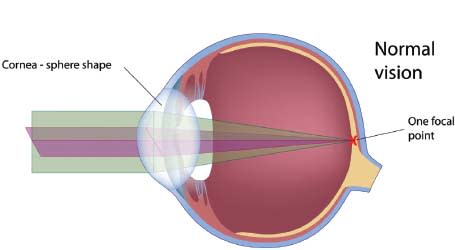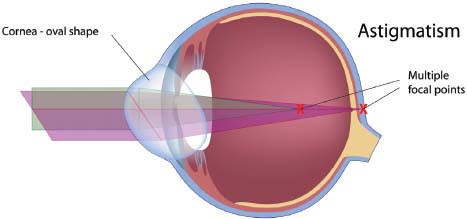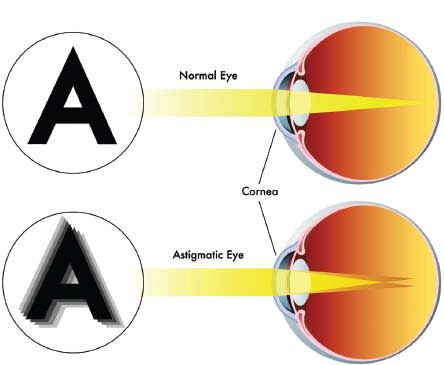Basics and Beyond: Astigmatism
Unraveling the mystery of this refractive error
By Jenean Carlton, BA, ABOC, NCLC
Some topics in the optical industry are difficult to comprehend and can even seem downright mysterious. Astigmatism is one of these topics because the optics that cause this refractive error, as well as the optics necessary to correct it, are complex and require more time and effort to fully understand.
This article discusses the fundamentals of astigmatism, symptoms that patients with astigmatism experience, and how spectacle lenses, and other modalities, improve vision for patients with this refractive error.
Astigmatism isn’t a disease or eye health condition; it’s a refractive error caused by focusing problems. It may be present from infancy or develop during childhood. It can also develop after an ocular injury, eye disease, or surgery.
It is estimated that approximately 33 percent of the U.S. population has some degree of astigmatism and that 70 percent of all Rx’s written in the U.S. include astigmatism correction.


AT A GLANCE
Astigmatism is most often caused by an ellipsoid (football-shaped) cornea or lens rather than a normal, spherically shaped cornea or lens. Less often, it is due to an irregular-shaped or displaced crystalline lens or corneal surface abnormality, such as a corneal scar.
In normal vision, the interaction of the cornea’s spherical shape and lens allows light to enter the eye and come to a single point of focus on the retina. With astigmatism, light enters the eye, refracts, and comes to multiple points of focus, each taking place at different locations in the eye. Because of the multiple focal points created by astigmatism, patients with this visual problem experience blurred vision.


Patients with uncorrected astigmatism view objects as blurred, like in the image at left. Patients with normal vision see objects clearly, like the image at right
TYPES AND TREATMENTS
■ Regular astigmatism is the most common form of astigmatism and is caused by the cornea or crystalline lens having an ellipsoid shape rather than the spherical shape of a normal cornea or lens. With an ellipsoid shape, the radius of curvature of the cornea or crystalline lens is not equal in all directions and results in astigmatism.
With regular astigmatism, the principal meridians of the cornea are perpendicular to one another, with one meridian being significantly steeper than the meridian perpendicular to it. Regular astigmatism can be corrected by using spherocylinder lenses (lenses that include a spherical power, cylinder power, and an axis), rigid spherical contact lenses, toric rigid contacts, toric soft contact lenses, and LASIK or other refractive surgeries. In addition, toric intraocular lenses (IOLs) can be implanted during cataract surgery to correct vision for astigmatism.
What Patients See
Astigmatism causes patients to experience uncomfortable, blurry vision at all distances. The degree of blurriness is dependent on the amount of astigmatism correction; the more irregular the shape of the cornea or crystalline lens, the more blurriness the refractive error will cause.
What is it like to have blurred vision? Blurred vision isn’t diplopia or double vision. With blurred vision objects don’t have clear borders; they have indistinct, fuzzy borders. With uncorrected astigmatism it may be possible to determine that an oncoming vehicle is a car but the shape of the car may not be clear. The same scenario is true when attempting to read road signs with uncorrected astigmatism. It might be possible to see the sign, and realize that words are printed on the sign, but impossible to accurately read the words because the letters appear blurred and distorted.
■ Irregular astigmatism can result from various corneal or lens irregularities, scarring as a result of injury, certain types of eye surgery, or from keratoconus, a disease causing a gradual thinning of the cornea. Irregularities of the front surface of the cornea can be seen with a keratometer or corneal topographer.
Glasses will not fully correct irregular corneal astigmatism. Instead, rigid contact lenses are generally prescribed to correct this type of astigmatism.
■ Lenticular astigmatism is due to an abnormality with the crystalline lens rather than the cornea. Lenticular astigmatism can be caused by an irregularly shaped crystalline lens or because of lens subluxation. Subluxation is when the lens becomes de-centered, often a result of trauma to the eye, which disrupts the fibers that hold the lens in place. Though off-center, the crystalline lens still remains visible through the pupil.
Lenticular astigmatism can be corrected with spectacles, contacts, and, if necessary, removal of the crystalline lens.
ASTIGMATISM Rx’S
■ Spherocylinder lenses. Ophthalmic lenses are divided into two categories: spherical lenses and cylindrical lenses. Spherical lenses have a single dioptric power and create a single point of focus. They have the same power in all meridians of the lens and a single radius of curvature. Spherical lenses correct vision for myopia and hyperopia but do not correct vision for astigmatism.
A cylindrical surface is one that has straight horizontal sides and round vertical sides, like the shape of a can. Cylindrical lens surfaces have no power in one direction and the maximum power 90 degrees away. The surface of the cylinder having no power is referred to as the axis. Astigmatism is corrected by lenses that have a cylinder component.
With spherocylinder lenses (also referred to as compound lenses as they include a spherical power, cylinder power, and an axis), the front surface of the lens is spherical and the back surface is cylindrical. This combination of front and back surfaces creates a prescription lens that corrects astigmatism. The sphere power is located along the axis and the sphere and cylinder power combined are present 90 degrees away from the axis.
The Symptoms
Patients with uncorrected astigmatism often report symptoms of eye strain, headaches, migraines, and eyelid twitching—particularly after using their eyes for a long period of time when performing visually demanding tasks like driving, reading, or using a computer. Squinting is a very common symptom of uncorrected astigmatism. Patients squint to minimize the lid opening which allows light to temporarily refract slightly better inside the eye.

In normal vision, light enters the eye and comes to a single focal point. With astigmatism, however, light comes to multiple points of focus in the eye
Spherocylinder lenses are toric lenses with varying powers along all of the meridians. One way to think of compound lenses is as a spherical lens sandwiched with a cylindrical lens, which has no power in one direction and the cylinder power in the other direction.
Prescriptions for astigmatism correction include spherical power, cylinder power, and axis. The axis designates the meridian of the lens that only has the sphere power in effect with a number from 1 to 180; the full cylinder power is located 90 degrees away from the axis.
Here is an example of a prescription that corrects astigmatism:
OD -.50 -1.00 × 180
OS -.50 -2.00 × 175
In this example, the spherical component of the right lens (OD) is -.50, meaning the patient is slightly myopic. The cylinder correction indicated on the prescription is -1.00, indicating that the patient has astigmatism in the right eye. To determine the full cylinder power, which is present 90 degrees away from the axis, it is necessary to combine the sphere and cylinder powers. Here’s our formula:
-.50 · (-1.00) + -1.50
In our example, the right lens has a power of -.50 at the 180 axis and -1.50 (the combined sphere and cylinder powers) at the 90-degree axis.
In this same example, the left lens (OS) indicates that the patient needs a -.50 spherical power for myopia and a -2.00 cylinder correction for astigmatism, with -2.50 combined sphere and cylinder powers.
Because the cylinder correction of the left lens (-2.00) is higher than the cylinder correction of the right lens (-1.00) we can presume that the patient’s uncorrected vision is more blurred with the left eye than is the right. The axis for both eyes falls between 150 and 180, so this prescription would correct “with-the-rule astigmatism,” (see sidebar, above) meaning the vertical meridian of each cornea is steeper than the horizontal meridians.
| Meridians and Rx’s |
|---|
|
Understanding a lens correction for astigmatism requires an understanding of meridians of the cornea. Visualize a clock face imposed over the front of the eye with a line connected vertically from the 12 o’clock to six o’clock position: this is the vertical meridian and approximately the 90-degree axis. A line from three to nine o’clock is the horizontal meridian and approximately the 180-degree axis. With astigmatism, the steepest and flattest meridians of the eye are called the principal meridians. The amount of astigmatism is equal to the difference in refracting power of the two principal meridians. ■ “With-the-rule” astigmatism occurs when the vertical meridian of the cornea is steepest. Consider a football shape lying on its side, and the vertical meridian of the football is the steepest curve. For these cases, spectacle lenses are fabricated with a minus cylinder placed in the horizontal axis. Placing a minus cylinder in the horizontal axis allows the horizontal meridian to become steeper, thereby neutralizing or balancing the steepness of the vertical meridian. Rx’s would have an axis within 30 degrees of 180, so the axis would be from 001 to 030 or from 150 to 180. ■ “Against-the-rule” astigmatism occurs when the horizontal meridian of the cornea is steepest—the horizontal meridian of the football is the steepest curve. For these cases, the minus cylinder is placed in the vertical axis; the vertical meridian then becomes steeper and thus neutralizes or balances the steepness of the horizontal meridian. Rx’s would have an axis within 30 degrees of 090, so the axis on the Rx would fall between 060 to 120. ■ Oblique astigmatism occurs when the steepest curve of the cornea isn’t in the vertical or horizontal meridians. It is rather in an oblique meridian between 120 and 150 degrees and 30 and 60 degrees. Spectacle Rx’s written for oblique astigmatism would have an axis that is not within 30 degrees of 090 and not within 30 degrees of 180. |
■ Transposition. Prescriptions may be written in plus or minus cylinder, depending on the equipment used by the doctor. Optometrists tend to refract in minus cylinder and ophthalmologists tend to refract in plus cylinder.
When it comes to fabricating lenses, most labs use minus cylinder form. This means that the ability to transpose prescriptions from plus cylinder to minus cylinder is a common and necessary skill.
Opticians working in practices will often need to be able to transpose prescriptions as well. It is worth noting that, regardless of which cylinder correction is used, the finished lenses correct vision in the same manner.

A “normal” eye (l) vs. an astigmatic eye (r). Image from the National Eye Institute/National Institutes of Health
Here are the steps to transposing cylinder power:
1. Algebraically add the sphere and cylinder powers to determine the new sphere power.
2. Keep the cylinder power the same but change the sign of the cylinder to minus.
3. Change the axis by 90 degrees.
For example, to transpose
-1.00 +3.00 × 045
1. Algebraically add the sphere and cylinder powers to determine the new sphere power.
(-1.00) + (+3.00) = +2.00
2. Keep the cylinder power the same but change the sign of the cylinder to minus cylinder.
-3.00
3. Change the axis by 90 degrees.
135
Because the axis is 045, we need to add 90 to the axis to come up with the new axis of 135, (045 + 90 = 135).
If the original axis were more than 90, we would subtract 90 to determine the new axis. The final prescription transposed to minus cylinder is +2.00 -3.00 x 135.
Astigmatism is a complex and confusing area of optics. Patients will routinely ask staff questions about their vision problems, especially once the eye exam is completed, to better understand their diagnosis. Gaining a better understanding of astigmatism, what causes this refractive error, and how to correct it with spectacle lenses and other modalities, will aid optical professionals in their communications with patients. EB



